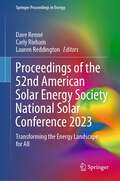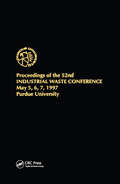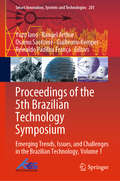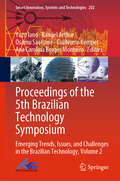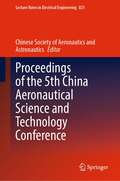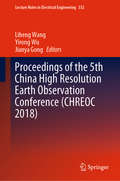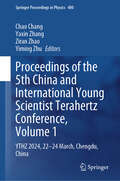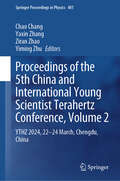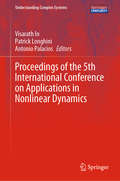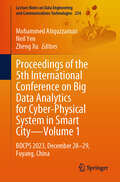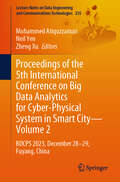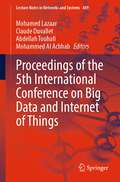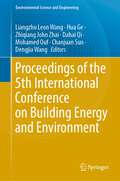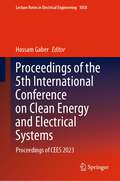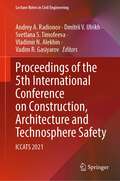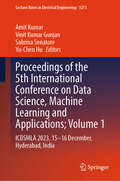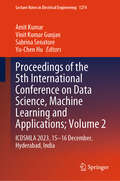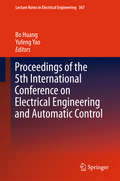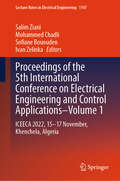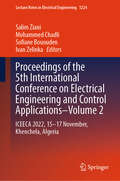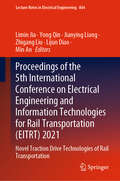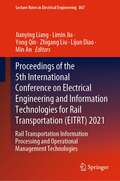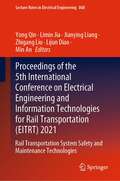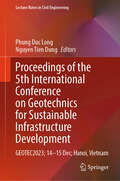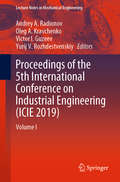- Table View
- List View
Proceedings of the 52nd American Solar Energy Society National Solar Conference 2023: Transforming the Energy Landscape for All (Springer Proceedings in Energy)
by Carly Rixham Dave Renné Lauren ReddingtonThis book highlights research presented during the American Solar Energy Society’s 52nd National Solar Conference (ASES SOLAR 2023) held at the University of Colorado Boulder. The conference, with the theme of “Transforming the Energy Landscape for All” attracted a broad base of solar and renewable energy professionals and thought leaders, including researchers, architects, engineers, entrepreneurs, installers, manufacturers, economists, finance professionals, and policymakers – providing a platform for the exchange of ideas, information and business insights and unbiased perspectives on progress toward greater sustainability. These conference papers explore best practices and major roadblocks from a variety of perspectives in the transformation towards 100% renewable energy in the United States, focusing on the challenges to advancing renewables through principles of justice, equity, diversity, and inclusion (JEDI).
Proceedings of the 52nd Purdue Industrial Waste Conference1997 Conference
by Purdue Research FoundationThe 52nd Purdue Industrial Waste Conference showcased 18 sessions on subjects such as biological aspects, physical-chemical aspects, oil and petroleum wastes, management and reuse strategies, international activities, and pollution prevention. This book compiles the work of nearly 200 international experts, covering the latest practical techniques, advanced research, new methods, actual operating data, and important case studies.
Proceedings of the 5th Brazilian Technology Symposium: Emerging Trends, Issues, and Challenges in the Brazilian Technology, Volume 1 (Smart Innovation, Systems and Technologies #201)
by Yuzo Iano Rangel Arthur Osamu Saotome Guillermo Kemper Reinaldo Padilha FrançaThis book presents the proceedings of the 5th Edition of the Brazilian Technology Symposium (BTSym). This event brings together researchers, students and professionals from the industrial and academic sectors, seeking to create and/or strengthen links between issues of joint interest, thus promoting technology and innovation at nationwide level. The BTSym facilitates the smart integration of traditional and renewable power generation systems, distributed generation, energy storage, transmission, distribution and demand management. The areas of knowledge covered by the event are Smart Designs, Sustainability, Inclusion, Future Technologies, IoT, Architecture and Urbanism, Computer Science, Information Science, Industrial Design, Aerospace Engineering, Agricultural Engineering, Biomedical Engineering, Civil Engineering, Control and Automation Engineering, Production Engineering, Electrical Engineering, Mechanical Engineering, Naval and Oceanic Engineering, Nuclear Engineering, Chemical Engineering, Probability and Statistics.
Proceedings of the 5th Brazilian Technology Symposium: Emerging Trends, Issues, and Challenges in the Brazilian Technology, Volume 2 (Smart Innovation, Systems and Technologies #202)
by Yuzo Iano Rangel Arthur Osamu Saotome Guillermo Kemper Ana Carolina Borges MonteiroThis book presents the proceedings of the 5th Edition of the Brazilian Technology Symposium (BTSym). This event brings together researchers, students and professionals from the industrial and academic sectors, seeking to create and/or strengthen links between issues of joint interest, thus promoting technology and innovation at nationwide level. The BTSym facilitates the smart integration of traditional and renewable power generation systems, distributed generation, energy storage, transmission, distribution and demand management. The areas of knowledge covered by the event are Smart Designs, Sustainability, Inclusion, Future Technologies, IoT, Architecture and Urbanism, Computer Science, Information Science, Industrial Design, Aerospace Engineering, Agricultural Engineering, Biomedical Engineering, Civil Engineering, Control and Automation Engineering, Production Engineering, Electrical Engineering, Mechanical Engineering, Naval and Oceanic Engineering, Nuclear Engineering, Chemical Engineering, Probability and Statistics.
Proceedings of the 5th China Aeronautical Science and Technology Conference (Lecture Notes in Electrical Engineering #821)
by Chinese Society of Aeronautics and AstronauticsTo sort out the progress of aviation science and technology and industry, look forward to the future development trend, commend scientific and technological innovation achievements and talents, strengthen international cooperation, promote discipline exchanges, encourage scientific and technological innovation, and promote the development of aviation, the Chinese Aeronautical Society holds a China Aviation Science and Technology Conference every two years, which has been successfully held for four times and has become the highest level, largest scale, most influential and authoritative science and technology conference in the field of aviation in China. The 5th China Aviation Science and Technology Conference will be held in Wuzhen, Jiaxing City, Zhejiang Province in 2021, with the theme of "New Generation of Aviation Equipment and Technology", with academician Zhang Yanzhong as the chairman of the conference.This book contains original, peer-reviewed research papers from the conference. The topics covered include but are not limited to navigation, guidance and control technologies, key technologies for aircraft design and overall optimization, aviation test technologies, aviation airborne systems, electromechanical technologies, structural design, aerodynamics and flight mechanics, other related technologies, advanced aviation materials and manufacturing technologies, advanced aviation propulsion technologies, and civil aviation transportation. The papers presented here share the latest discoveries on aviation science and technology, making the book a valuable asset for researchers, engineers, and students.
Proceedings of the 5th China High Resolution Earth Observation Conference (Lecture Notes in Electrical Engineering #552)
by Liheng Wang Yirong Wu Jianya GongThis book is the proceedings of the 5th China High-resolution Earth Observation Conference (CHREOC). The series conference of China High Resolution Earth Observation has been becoming the influential academic event in the earth detection area, and attracting more and more top experts and industry users of related fields. The CHREOCs focus on the popular topics including military-civilian integration, the One Belt and One Road project, the transformation of scientific research achievements, and it also discusses the new ideas, new technologies, new methods, and new developments. The CHREOCs have effectively promoted high-level institutional mechanisms, technological innovation, and industrial upgrading in the high-resolution earth observation area, and arouse the influence of the national-sponsored major project. All papers in this proceeding are from the 5th CHREOC, and most authors are the researchers and experts participating the state major project CHEOS. The papers are the extraction of research results and reflect the technique level and research direction of the field high-resolution earth observation. All articles have gone through the scientific and strict reviews for several rounds by the experts from the related fields, and therefore reflect the research level and technology innovation of the high-resolution field earth observation. This proceedings will be an informative and valuable reference for both academic research and engineering practice.
Proceedings of the 5th China and International Young Scientist Terahertz Conference, Volume 1: YTHZ 2024, 22-24 March, Chengdu, China (Springer Proceedings in Physics #400)
by Chao Chang Yaxin Zhang Ziran Zhao Yiming ZhuThe Proceedings of the 5th China and International Young Scientist Terahertz Conference highlight important research and technological progresses on terahertz sensors, terahertz detection, terahertz biophysics and bioeffects, terahertz signal sources, terahertz transmission and regulation, terahertz device and materials, terahertz communication, terahertz radar and imaging, and the intersection and application of terahertz-related disciplines.
Proceedings of the 5th China and International Young Scientist Terahertz Conference, Volume 2: YTHZ 2024, 22-24 March, Chengdu, China (Springer Proceedings in Physics #401)
by Chao Chang Yaxin Zhang Ziran Zhao Yiming ZhuThe Proceedings of the 5th China and International Young Scientist Terahertz Conference highlight the important research and technological progresses on terahertz signal sources, terahertz detection, terahertz biophysics, terahertz transmission, terahertz regulation, terahertz device and materials, terahertz communication, terahertz radar and imaging, terahertz spectroscopy and biotechnology, and the intersection and application of terahertz-related disciplines.
Proceedings of the 5th International Conference on Applications in Nonlinear Dynamics (Understanding Complex Systems #6)
by Visarath In Antonio Palacios Patrick LonghiniThis book presents collaborative research presented by experts in the field of nonlinear science provides the reader with contemporary, cutting-edge, research works that bridge the gap between theory and device realizations of nonlinear phenomena. The conference provides a unique forum for applications of nonlinear systems while solving practical problems in science and engineering. Topics include: chaos gates, social networks, communication, sensors, lasers, molecular motors, biomedical anomalies, and stochastic resonance. This book provides a comprehensive report of the various research projects presented at the International Conference on Applications in Nonlinear Dynamics (ICAND 2018) held in Maui, Hawaii, 2018. It can be a valuable tool for scientists and engineering interested in connecting ideas and methods in nonlinear dynamics with actual design, fabrication and implementation of engineering applications or devices.
Proceedings of the 5th International Conference on Big Data Analytics for Cyber-Physical System in Smart City—Volume 1: BDCPS 2023, December 28–29, Fuyang, China (Lecture Notes on Data Engineering and Communications Technologies #234)
by Mohammed Atiquzzaman Zheng Xu Neil YenThis book gathers a selection of peer-reviewed papers presented at the 5th Big Data Analytics for Cyber-Physical System in Smart City (BDCPS 2023) conference, held in Fuyang, China, on December 28–29. The contributions, prepared by an international team of scientists and engineers, cover the latest advances and challenges made in the field of big data analytics methods and approaches for the data-driven co-design of communication, computing, and control for smart cities. Given its scope, it offers a valuable resource for all researchers and professionals interested in big data, smart cities, and cyber-physical systems.
Proceedings of the 5th International Conference on Big Data Analytics for Cyber-Physical System in Smart City—Volume 2: BDCPS 2023, December 28–29, Fuyang, China (Lecture Notes on Data Engineering and Communications Technologies #235)
by Mohammed Atiquzzaman Zheng Xu Neil YenThis book gathers a selection of peer-reviewed papers presented at the 5th Big Data Analytics for Cyber-Physical System in Smart City (BDCPS 2023) conference, held in Fuyang, China, on December 28–29. The contributions, prepared by an international team of scientists and engineers, cover the latest advances and challenges made in the field of big data analytics methods and approaches for the data-driven co-design of communication, computing, and control for smart cities. Given its scope, it offers a valuable resource for all researchers and professionals interested in big data, smart cities, and cyber-physical systems.
Proceedings of the 5th International Conference on Big Data and Internet of Things (Lecture Notes in Networks and Systems #489)
by Mohamed Lazaar Mohammed Al Achhab Claude Duvallet Abdellah TouhafiThis book is a collection of papers in the research area of big data, cloud computing, cybersecurity, machine learning, deep learning, e-learning, Internet of Things, reinforcement learning, information system, social media and natural language processing. This book includes papers presented at the 5th International Conference on Big Data Cloud and Internet of Things, BDIoT 2021 during March 17–18, 2021, at ENSIAS, Mohammed V University in Rabat, Morocco.
Proceedings of the 5th International Conference on Building Energy and Environment (Environmental Science and Engineering)
by Hua Ge Zhiqiang John Zhai Liangzhu Leon Wang Dahai Qi Mohamed Ouf Chanjuan Sun Dengjia WangThis book is a compilation of selected papers from the 5th International Conference on Building Energy and Environment (COBEE2022), held in Montreal, Canada, in July 2022. The work focuses on the most recent technologies and knowledge of building energy and the environment, including health, energy, urban microclimate, smart cities, safety, etc. The contents make valuable contributions to academic researchers, engineers in the industry, and regulators of buildings. As well, readers encounter new ideas for achieving healthy, comfortable, energy-efficient, resilient, and safe buildings.
Proceedings of the 5th International Conference on Clean Energy and Electrical Systems: Proceedings of CEES 2023 (Lecture Notes in Electrical Engineering #1058)
by Hossam GaberThis book provides readers with peer-reviewed research papers presented at the 5th International Conference on Clean Energy and Electrical Systems held in Tokyo, Japan, from April 1 to 4, 2023. This proceedings mainly covers theoretical, technical, and practical methods and practices on clean energy and electrical systems. And it includes nuclear energy and "renewable energy." With the continuous growth of energy demand and the increasing awareness of environmental protection in countries around the world, it is urgent and imperative to establish a clean energy innovation research and development, promotion, and application system. The book also covers electricity, fuel, thermal, transportation, and water infrastructures and their development and deployment in different regions around the world. The book includes future development trends with analysis of lifecycle and economical models for successful implementation projects.
Proceedings of the 5th International Conference on Construction, Architecture and Technosphere Safety: ICCATS 2021 (Lecture Notes in Civil Engineering #168)
by Andrey A. Radionov Vadim R. Gasiyarov Dmitrii V. Ulrikh Svetlana S. Timofeeva Vladimir N. AlekhinThis book highlights recent findings in civil and environmental engineering and urban planning, and provides an overview of the state of the art in these fields, mainly in Russia and Eastern Europe. A broad range of topics and issues in modern engineering are discussed, including construction, buildings and structures, advanced materials, innovative technology, methods and techniques in civil engineering, heating, gas supply, water supply and sewerage, foundation engineering, BIM, structural reliability, durability and monitoring, special and unique structures construction (bridge, tunnel, road, railway engineering), design and construction of hydraulic structures, concrete engineering, urban regeneration and sustainable development, urban transport system, engineering structure safety and disaster prevention, water resources engineering, water and wastewater treatment, recycling and reuse of wastewater, etc. The volume gathers selected papers from the 5th International Conference on Construction, Architecture and Technosphere Safety (ICCATS), held in Sochi, Russia in September 2021. The authors are experts in various fields of engineering, and all papers have been carefully reviewed.
Proceedings of the 5th International Conference on Data Science, Machine Learning and Applications; Volume 1: ICDSMLA 2023, 15–16 December, Hyderabad, India (Lecture Notes in Electrical Engineering #1273)
by Amit Kumar Yu-Chen Hu Vinit Kumar Gunjan Sabrina SenatoreThis book (Volume 1) includes peer reviewed articles from the 5th International Conference on Data Science, Machine Learning and Applications, 2023, held at the G Narayanamma Institute of Technology and Sciences, Hyderabad on 15-16th December, India. ICDSMLA is one of the most prestigious conferences conceptualized in the field of Data Science & Machine Learning offering in-depth information on the latest developments in Artificial Intelligence, Machine Learning, Soft Computing, Human Computer Interaction, and various data science & machine learning applications. It provides a platform for academicians, scientists, researchers and professionals around the world to showcase broad range of perspectives, practices, and technical expertise in these fields. It offers participants the opportunity to stay informed about the latest developments in data science and machine learning.
Proceedings of the 5th International Conference on Data Science, Machine Learning and Applications; Volume 2: ICDSMLA 2023, 15–16 December, Hyderabad, India (Lecture Notes in Electrical Engineering #1274)
by Amit Kumar Yu-Chen Hu Vinit Kumar Gunjan Sabrina SenatoreThis book includes peer reviewed articles from the 5th International Conference on Data Science, Machine Learning and Applications, 2023, held at the G Narayanamma Institute of Technology and Sciences, Hyderabad on 15-16th December, India. ICDSMLA is one of the most prestigious conferences conceptualized in the field of Data Science & Machine Learning offering in-depth information on the latest developments in Artificial Intelligence, Machine Learning, Soft Computing, Human Computer Interaction, and various data science & machine learning applications. It provides a platform for academicians, scientists, researchers and professionals around the world to showcase broad range of perspectives, practices, and technical expertise in these fields. It offers participants the opportunity to stay informed about the latest developments in data science and machine learning.
Proceedings of the 5th International Conference on Electrical Engineering and Automatic Control
by Bo Huang Yufeng YaoOn the basis of instrument electrical and automatic control system, the 5th International Conference on Electrical Engineering and Automatic Control (CEEAC) was established at the crossroads of information technology and control technology, and seeks to effectively apply information technology to a sweeping trend that views control as the core of intelligent manufacturing and life. This book takes a look forward into advanced manufacturing development, an area shaped by intelligent manufacturing. It highlights the application and promotion of process control represented by traditional industries, such as the steel industry and petrochemical industry; the technical equipment and system cooperative control represented by robot technology and multi-axis CNC; and the control and support of emerging process technologies represented by laser melting and stacking, as well as the emerging industry represented by sustainable and intelligent life. The book places particular emphasis on the micro-segments field, such as intelligent micro-grids, new energy vehicles, and the Internet of Things.
Proceedings of the 5th International Conference on Electrical Engineering and Control Applications–Volume 1: ICEECA 2022, 15–17 November, Khenchela, Algeria (Lecture Notes in Electrical Engineering #1147)
by Ivan Zelinka Mohammed Chadli Sofiane Bououden Salim ZianiThis book gathers papers presented during the 5th International Conference on Electrical Engineering and Control Applications (ICEECA 2022), held on November, 15–17, 2022, Khenchela, Algeria. It covers new control system models, troubleshooting tips, and complex system requirements, such as increased speed, precision, and remote capabilities. Additionally, the book discusses not only the engineering aspects of signal processing and various practical issues in the broad field of information transmission, but also novel technologies for communication networks and modern antenna design. The later part of the book covers important related topics such as fault diagnosis and fault-tolerant control strategies for nonlinear systems and alternative energy sources. This book is intended for researchers, engineers, and advanced postgraduate students in the fields of control and electrical engineering, computer science, signal processing, as well as mechanical and chemical engineering.
Proceedings of the 5th International Conference on Electrical Engineering and Control Applications–Volume 2: ICEECA 2022, 15–17 November, Khenchela, Algeria (Lecture Notes in Electrical Engineering #1224)
by Ivan Zelinka Mohammed Chadli Sofiane Bououden Salim ZianiThis book gathers papers presented during the 5th International Conference on Electrical Engineering and Control Applications (ICEECA 2022), held on November, 15–17, 2022, Khenchela, Algeria. It covers new control system models, troubleshooting tips, and complex system requirements, such as increased speed, precision, and remote capabilities. Additionally, the book discusses not only the engineering aspects of signal processing and various practical issues in the broad field of information transmission, but also novel technologies for communication networks and modern antenna design. The later part of the book covers important related topics such as fault diagnosis and fault-tolerant control strategies for nonlinear systems and alternative energy sources. This book is intended for researchers, engineers, and advanced postgraduate students in the fields of control and electrical engineering, computer science, signal processing, as well as mechanical and chemical engineering.
Proceedings of the 5th International Conference on Electrical Engineering and Information Technologies for Rail Transportation: Novel Traction Drive Technologies of Rail Transportation (Lecture Notes in Electrical Engineering #864)
by Zhigang Liu Limin Jia Yong Qin Lijun Diao Min An Jianying LiangThis book reflects the latest research trends, methods and experimental results in the field of electrical and information technologies for rail transportation, which covers abundant state-of-the-art research theories and ideas. As a vital field of research that is highly relevant to current developments in a number of technological domains, the subjects it covered include intelligent computing, information processing, communication technology, automatic control, etc. The objective of the proceedings is to provide a major interdisciplinary forum for researchers, engineers, academicians and industrial professionals to present the most innovative research and development in the field of rail transportation electrical and information technologies. Engineers and researchers in academia, industry and government will also explore an insightful view of the solutions that combine ideas from multiple disciplines in this field. The volumes serve as an excellent reference work for researchers and graduate students working on rail transportation and electrical and information technologies.
Proceedings of the 5th International Conference on Electrical Engineering and Information Technologies for Rail Transportation: Rail Transportation Information Processing and Operational Management Technologies (Lecture Notes in Electrical Engineering #867)
by Zhigang Liu Limin Jia Yong Qin Lijun Diao Min An Jianying LiangThis book reflects the latest research trends, methods, and experimental results in the field of electrical and information technologies for rail transportation, which covers abundant state-of-the-art research theories and ideas. As a vital field of research that is highly relevant to current developments in a number of technological domains, the subjects it covered include intelligent computing, information processing, communication technology, automatic control, etc. The objective of the proceedings is to provide a major interdisciplinary forum for researchers, engineers, academicians, and industrial professionals to present the most innovative research and development in the field of rail transportation electrical and information technologies. Engineers and researchers in academia, industry, and government will also explore an insightful view of the solutions that combine ideas from multiple disciplines in this field. The volumes serve as an excellent reference work for researchers and graduate students working on rail transportation and electrical and information technologies.
Proceedings of the 5th International Conference on Electrical Engineering and Information Technologies for Rail Transportation: Rail Transportation System Safety and Maintenance Technologies (Lecture Notes in Electrical Engineering #868)
by Zhigang Liu Limin Jia Yong Qin Lijun Diao Min An Jianying LiangThis book reflects the latest research trends, methods, and experimental results in the field of electrical and information technologies for rail transportation, which covers abundant state-of-the-art research theories and ideas. As a vital field of research that is highly relevant to current developments in a number of technological domains, the subjects it covered include intelligent computing, information processing, communication technology, automatic control, etc. The objective of the proceedings is to provide a major interdisciplinary forum for researchers, engineers, academicians, and industrial professionals to present the most innovative research and development in the field of rail transportation electrical and information technologies. Engineers and researchers in academia, industry, and government will also explore an insightful view of the solutions that combine ideas from multiple disciplines in this field. The volumes serve as an excellent reference work for researchers and graduate students working on rail transportation and electrical and information technologies.
Proceedings of the 5th International Conference on Geotechnics for Sustainable Infrastructure Development: GEOTEC2023; 14–15 Dec; Hanoi, Vietnam (Lecture Notes in Civil Engineering #395)
by Nguyen Tien Dung Phung Duc LongThis book presents 204 peer reviewed articles from the 5th International Conference on Geotechnics for Sustainable Infrastructure Development (GEOTEC HANOI 2023) held on 14-15 Dec 2023 in Hanoi, Vietnam. The papers come from nearly 40 countries of the five different continents and are grouped into six conference themes: 1) Deep Foundations; 2) Tunnelling and Underground Spaces; 3) Ground Improvement; 4) Landslide and Erosion; 5) Geotechnical Modelling and Monitoring; and 6) Offshore Wind Power.
Proceedings of the 5th International Conference on Industrial Engineering: Volume I (Lecture Notes in Mechanical Engineering)
by Andrey A. Radionov Oleg A. Kravchenko Victor I. Guzeev Yurij V. RozhdestvenskiyThis book highlights recent findings in industrial, manufacturing and mechanical engineering, and provides an overview of the state of the art in these fields, mainly in Russia and Eastern Europe. A broad range of topics and issues in modern engineering are discussed, including the dynamics of machines and working processes, friction, wear and lubrication in machines, surface transport and technological machines, manufacturing engineering of industrial facilities, materials engineering, metallurgy, control systems and their industrial applications, industrial mechatronics, automation and robotics. The book gathers selected papers presented at the 5th International Conference on Industrial Engineering (ICIE), held in Sochi, Russia in March 2019. The authors are experts in various fields of engineering, and all papers have been carefully reviewed. Given its scope, the book will be of interest to a wide readership, including mechanical and production engineers, lecturers in engineering disciplines, and engineering graduates.
